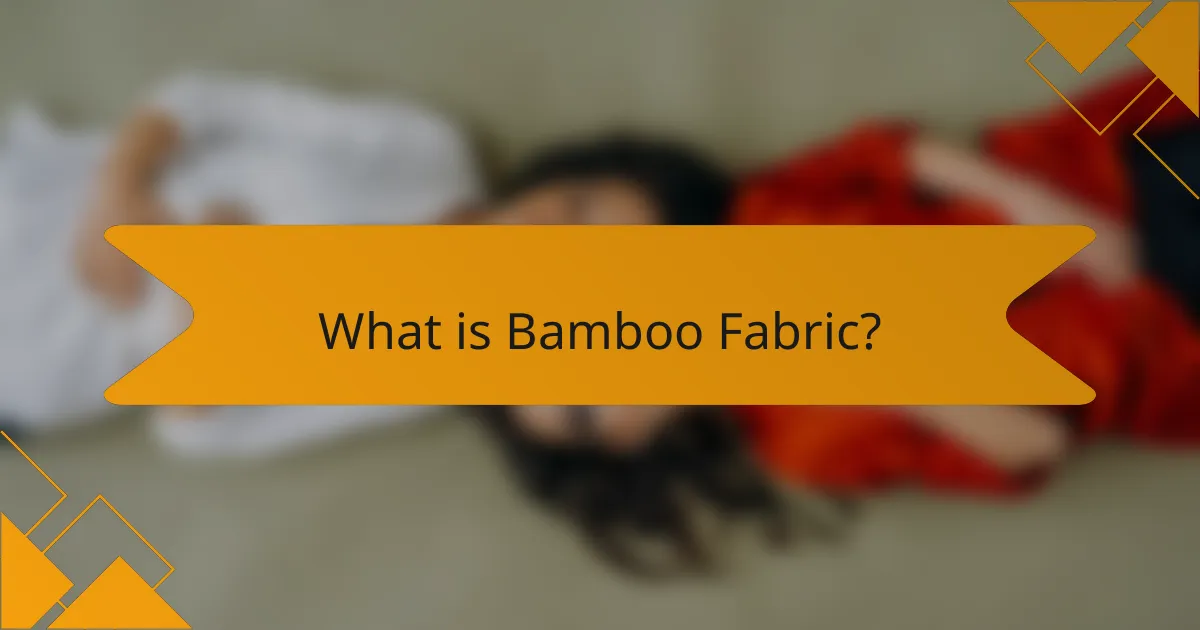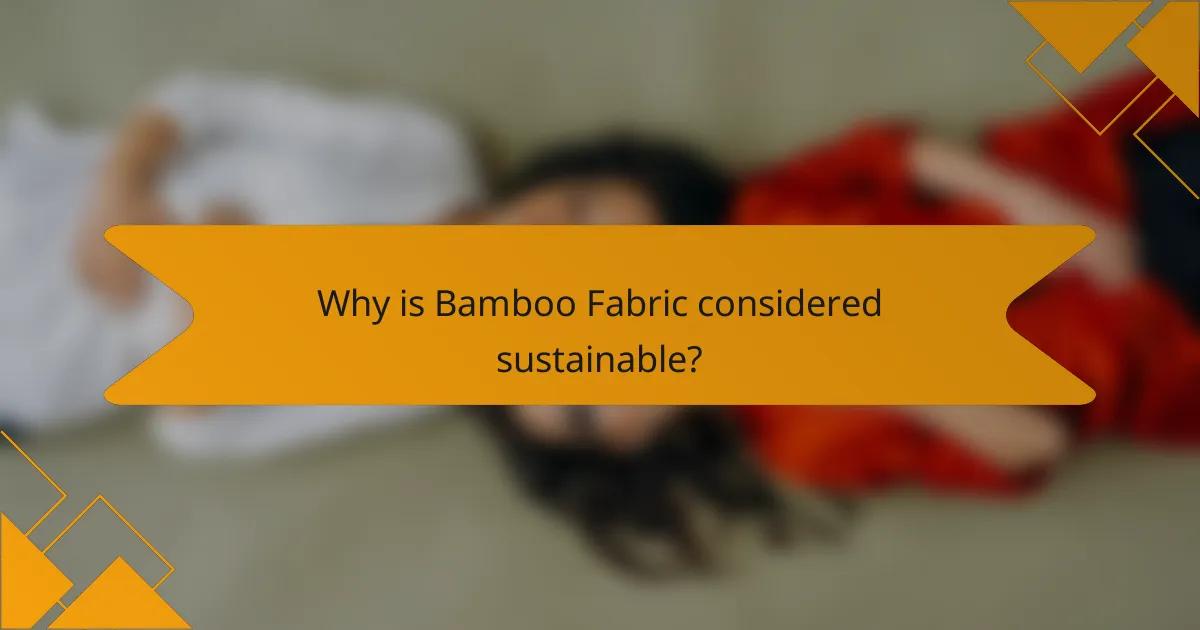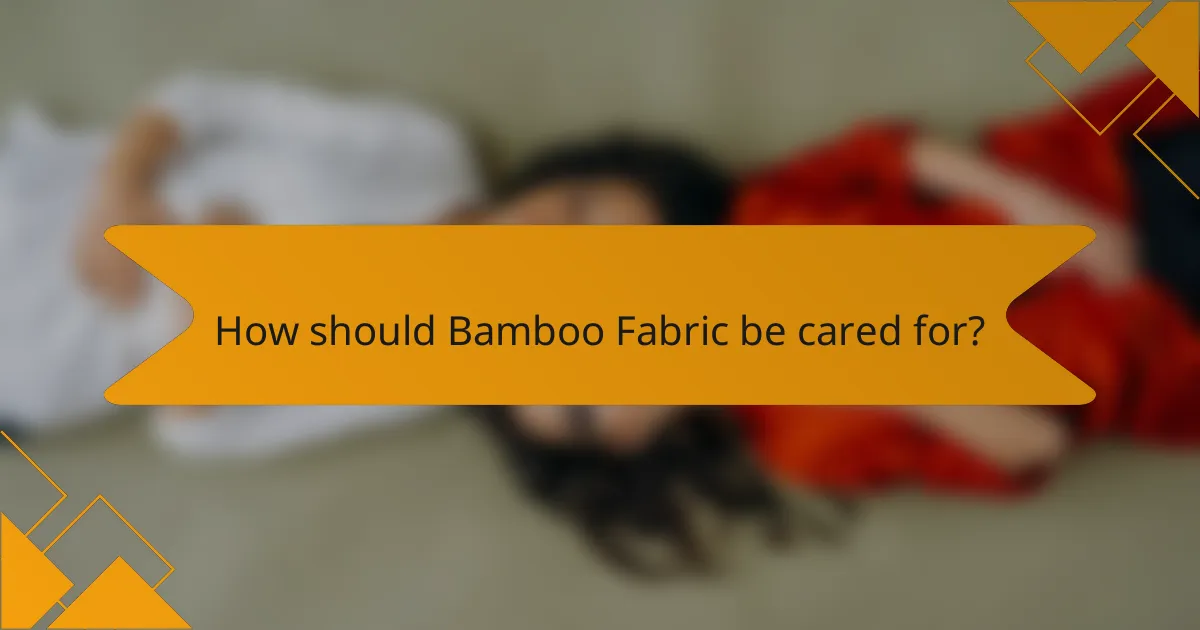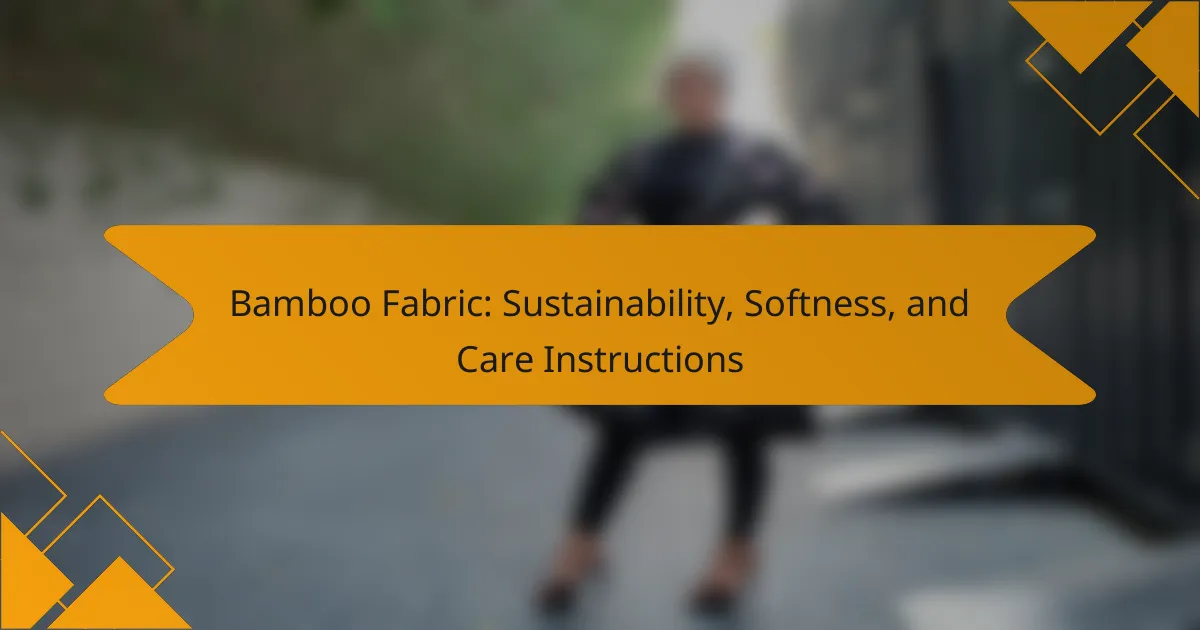Bamboo fabric is a textile derived from the pulp of the bamboo plant, recognized for its softness, breathability, and natural antibacterial properties. This eco-friendly fabric is biodegradable and requires fewer chemicals in its production compared to conventional textiles. Bamboo grows rapidly, necessitating minimal water and no pesticides, which contributes to its sustainable profile. The article will explore the benefits of bamboo fabric, including its environmental impact, care instructions, and its suitability for clothing and home textiles. Additionally, it highlights the cultivation advantages of bamboo, such as soil health improvement and carbon dioxide absorption.

What is Bamboo Fabric?
Bamboo fabric is a textile made from the pulp of the bamboo plant. It is known for its softness and breathability. Bamboo fibers are naturally antibacterial and hypoallergenic. The fabric is often used in clothing and home textiles. Bamboo fabric is also biodegradable, making it an eco-friendly choice. Its production process can require fewer chemicals compared to conventional fabrics. Additionally, bamboo grows rapidly, providing a sustainable resource. Studies indicate that bamboo cultivation can help reduce soil erosion and improve soil health.
How is Bamboo Fabric made?
Bamboo fabric is made through a process that converts bamboo pulp into fibers. First, bamboo stalks are harvested and crushed. The crushed bamboo is then soaked in a solution to break down the cellulose. Afterward, the cellulose is extracted and spun into fibers. These fibers are then woven or knitted to create fabric. The process can vary, with some methods using chemicals while others utilize mechanical processes. The resulting bamboo fabric is known for its softness and breathability. It is also biodegradable, making it an eco-friendly choice.
What processes are involved in converting bamboo into fabric?
The processes involved in converting bamboo into fabric include harvesting, processing, and spinning. First, bamboo stalks are harvested when they reach maturity, typically between three to five years. Next, the harvested bamboo is processed through methods such as mechanical or chemical pulping. Mechanical pulping involves crushing the bamboo to extract fibers, while chemical pulping uses solvents to dissolve the lignin and separate the cellulose fibers. After pulping, the bamboo fibers are washed and bleached, if necessary, to achieve desired whiteness. The cleaned fibers are then dried and carded to align them. Finally, the aligned fibers are spun into yarn, which can be woven or knitted into fabric. This process results in soft, breathable bamboo fabric commonly used in clothing and textiles.
What are the key materials used in Bamboo Fabric production?
The key materials used in bamboo fabric production are bamboo pulp and various chemical solvents. Bamboo pulp is derived from the bamboo plant, which is processed to extract cellulose. This cellulose is then dissolved in a solvent to create a viscous solution. The solution is extruded through spinnerets to form fibers. These fibers are then spun into yarn for fabric production. The chemical solvents used can vary, with some processes utilizing environmentally friendly options. The production process impacts the sustainability of the final fabric.
What are the characteristics of Bamboo Fabric?
Bamboo fabric is known for its softness, breathability, and moisture-wicking properties. It is derived from the pulp of the bamboo plant, making it a sustainable choice. Bamboo fabric is naturally antibacterial and hypoallergenic, which benefits sensitive skin. It has excellent thermal regulating properties, keeping the wearer cool in summer and warm in winter. The fabric is biodegradable, contributing to environmental sustainability. Additionally, bamboo fabric is durable and resistant to wrinkles, enhancing its usability. Studies show that bamboo cultivation requires less water compared to cotton, further supporting its eco-friendly profile.
How does the softness of Bamboo Fabric compare to other fabrics?
Bamboo fabric is generally softer than many other fabrics, such as cotton and polyester. Its natural fibers create a smooth texture that feels gentle against the skin. In a comparison, bamboo fabric has a softness rating that often exceeds that of traditional cotton. According to studies, bamboo fabric can be up to 3 times softer than cotton. This softness is due to the fiber structure of bamboo, which is more rounded and less abrasive than cotton fibers. Additionally, bamboo fabric is breathable and moisture-wicking, enhancing its comfort level. Overall, the softness of bamboo fabric makes it a preferred choice for clothing and bedding.
What are the moisture-wicking properties of Bamboo Fabric?
Bamboo fabric has excellent moisture-wicking properties. It efficiently absorbs and evaporates moisture from the skin. This ability keeps the wearer dry and comfortable in various conditions. Bamboo fibers can absorb up to three times their weight in water. The fabric’s natural structure promotes airflow, enhancing breathability. Studies show that bamboo fabric reduces the growth of bacteria, which helps prevent odor. These properties make bamboo fabric suitable for activewear and undergarments. Overall, bamboo fabric combines comfort and functionality effectively.

Why is Bamboo Fabric considered sustainable?
Bamboo fabric is considered sustainable due to its rapid growth and minimal environmental impact. Bamboo can grow up to three feet in a single day without the need for pesticides or fertilizers. It requires significantly less water than traditional crops like cotton. Additionally, bamboo absorbs more carbon dioxide and releases more oxygen compared to many trees. The production process for bamboo fabric is often less harmful than synthetic fabrics, as it can be processed using eco-friendly methods. Furthermore, bamboo is biodegradable, which reduces waste in landfills. These characteristics contribute to its reputation as an environmentally friendly textile choice.
What are the environmental benefits of Bamboo cultivation?
Bamboo cultivation offers significant environmental benefits. It absorbs carbon dioxide at a higher rate than most trees. This helps mitigate climate change by reducing greenhouse gases in the atmosphere. Bamboo also produces oxygen, contributing to improved air quality. The plant requires minimal water compared to traditional crops, making it more sustainable in water-scarce areas. Its deep root system prevents soil erosion and promotes soil health. Bamboo can grow rapidly, reaching maturity in three to five years. This fast growth reduces the need for deforestation, preserving biodiversity. Additionally, bamboo supports wildlife habitats, providing shelter and food for various species.
How does Bamboo growth impact carbon dioxide levels?
Bamboo growth significantly reduces carbon dioxide levels. Bamboo is known for its rapid growth rate, which can reach up to 91 cm (35 inches) in a single day. During this growth, bamboo absorbs large quantities of carbon dioxide from the atmosphere. Research indicates that bamboo can absorb carbon dioxide at a rate of 12 tons per hectare annually. This makes bamboo one of the most effective plants for carbon sequestration. Additionally, bamboo releases oxygen during photosynthesis, further contributing to improved air quality. The combination of high growth rates and substantial carbon absorption makes bamboo a valuable asset in combating climate change.
What makes Bamboo a renewable resource?
Bamboo is a renewable resource because it grows rapidly and can regenerate without replanting. It can reach maturity in three to five years. Unlike traditional timber, bamboo can be harvested without killing the plant. This allows it to continue growing and producing new shoots. Bamboo also has a high carbon sequestration capacity. It absorbs more carbon dioxide than many trees. Additionally, bamboo requires less water and no pesticides for cultivation. These factors contribute to its sustainability and renewability as a resource.
How does Bamboo Fabric contribute to sustainable fashion?
Bamboo fabric contributes to sustainable fashion through its eco-friendly production process. Bamboo grows rapidly, requiring minimal water and no pesticides. This makes it a renewable resource. The processing of bamboo into fabric uses less energy compared to traditional textiles. Bamboo fabric is biodegradable, reducing landfill waste. Additionally, it has natural antibacterial properties, reducing the need for chemical treatments. These attributes make bamboo a sustainable choice for environmentally conscious consumers.
What role does Bamboo Fabric play in reducing textile waste?
Bamboo fabric plays a significant role in reducing textile waste. It is biodegradable, which means it decomposes naturally and does not contribute to landfill accumulation. The production process of bamboo fabric often uses less water and energy compared to conventional cotton. This efficiency leads to lower overall resource consumption and waste generation. Additionally, bamboo can grow rapidly, allowing for sustainable harvesting without depleting resources. A study by the Textile Exchange highlights that bamboo cultivation can reduce the need for synthetic fibers, which are often non-biodegradable. Thus, bamboo fabric contributes to a more sustainable textile industry by minimizing waste and promoting eco-friendly practices.
How does using Bamboo Fabric support ethical manufacturing practices?
Using bamboo fabric supports ethical manufacturing practices by promoting sustainable sourcing and reducing environmental impact. Bamboo is a fast-growing plant that requires minimal water and no pesticides. This leads to lower resource consumption compared to conventional cotton production. Additionally, ethical manufacturers often use closed-loop processes to convert bamboo into fabric. This minimizes waste and chemical runoff. Certification programs like OEKO-TEX ensure that bamboo fabrics meet environmental and social standards. These practices contribute to fair labor conditions and lower carbon footprints in the textile industry.

How should Bamboo Fabric be cared for?
Bamboo fabric should be cared for by washing it in cold water. Use a gentle cycle to prevent damage. Avoid using bleach or harsh detergents, as they can harm the fibers. Instead, opt for mild detergents. Air drying is recommended to maintain the fabric’s integrity. If using a dryer, select a low heat setting. Iron on a low setting if necessary. Bamboo fabric is prone to wrinkling, so handle it carefully. Following these guidelines helps prolong the lifespan of bamboo fabric.
What are the best washing practices for Bamboo Fabric?
The best washing practices for bamboo fabric include washing in cold water. Cold water helps preserve the fabric’s softness and prevents shrinkage. Use a gentle cycle to minimize wear and tear. Avoid bleach and harsh detergents, as they can damage the fibers. Instead, opt for mild, eco-friendly detergents. Air drying is recommended to maintain the fabric’s integrity. If using a dryer, select a low heat setting. These practices help extend the lifespan of bamboo fabric while keeping it clean and comfortable.
Should Bamboo Fabric be washed in hot or cold water?
Bamboo fabric should be washed in cold water. Washing in cold water helps maintain the fabric’s softness and prevents shrinking. Hot water can damage the fibers and lead to a loss of quality. Cold water is also more energy-efficient, aligning with sustainable practices. Many care labels recommend cold washing for bamboo textiles to extend their lifespan.
What detergents are safe to use with Bamboo Fabric?
Mild, eco-friendly detergents are safe to use with bamboo fabric. Look for detergents that are free from harsh chemicals, bleach, and fabric softeners. Brands like Seventh Generation and Ecover offer suitable options. These detergents help maintain the softness and durability of bamboo fibers. Additionally, using cold water for washing preserves the fabric’s quality. Always follow care labels for specific instructions.
How can you maintain the longevity of Bamboo Fabric items?
To maintain the longevity of bamboo fabric items, wash them in cold water. Hot water can damage the fibers. Use a gentle detergent to avoid harsh chemicals. Avoid bleach, as it can weaken the fabric. Air dry bamboo items instead of using a dryer. High heat can cause shrinkage and damage. Iron on a low setting if necessary. Bamboo fabric is prone to wrinkling, so handle it with care. Store items in a cool, dry place to prevent mildew. Following these care instructions can significantly extend the lifespan of bamboo fabric.
What drying methods are recommended for Bamboo Fabric?
Air drying is the recommended method for drying bamboo fabric. This method helps maintain the fabric’s softness and durability. It is best to hang bamboo fabric in a shaded area to prevent sun damage. Avoid direct sunlight as it can fade the color and weaken the fibers. If using a dryer, select a low heat setting to minimize damage. High heat can cause shrinkage and loss of shape. Bamboo fabric should not be wrung out to remove excess water, as this can distort its structure. Instead, gently squeeze out water without twisting. Following these methods ensures the longevity and quality of bamboo fabric.
How should Bamboo Fabric be stored to prevent damage?
Bamboo fabric should be stored in a cool, dry place to prevent damage. Humidity can lead to mold growth and fabric degradation. It is essential to keep bamboo fabric away from direct sunlight. Prolonged exposure to sunlight can cause fading and weakening of the fibers. Additionally, bamboo fabric should be folded neatly rather than hung to avoid stretching. Using breathable storage bags can also help maintain its quality. Proper storage practices can extend the lifespan of bamboo fabric significantly.
What tips can help you choose quality Bamboo Fabric products?
To choose quality bamboo fabric products, look for certifications such as Oeko-Tex Standard 100. This certification ensures the fabric is free from harmful substances. Check the fabric’s weight; higher GSM indicates better quality. A weight of 200-300 GSM is ideal for durability. Examine the weave; a tighter weave usually means better quality and longevity. Feel the fabric; quality bamboo fabric should be soft and smooth to touch. Research the brand’s manufacturing processes; reputable brands prioritize sustainable practices. Lastly, read customer reviews to gauge satisfaction with the product’s performance and durability.
Bamboo fabric is a textile derived from the pulp of the bamboo plant, recognized for its softness, breathability, and eco-friendly properties. This article covers the production process of bamboo fabric, highlighting key materials, characteristics, and its sustainability benefits. It explores how bamboo cultivation contributes to environmental health, including carbon dioxide absorption and soil preservation. Additionally, the article provides care instructions for maintaining bamboo fabric, ensuring longevity while emphasizing ethical manufacturing practices and tips for selecting quality products.


